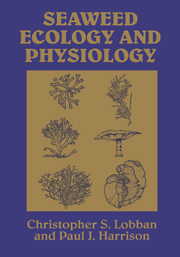Book contents
- Frontmatter
- Contents
- List of contributors
- Preface
- 1 Morphology, life histories, and morphogenesis
- 2 Seaweed communities
- 3 Biotic interactions
- 4 Light and photosynthesis
- 5 Nutrients
- 6 Temperature and salinity
- 7 Water motion
- 8 Pollution
- 9 Seaweed mariculture
- Appendix: Taxonomic classification of algae mentioned in the text
- References
- Index
8 - Pollution
Published online by Cambridge University Press: 18 December 2009
- Frontmatter
- Contents
- List of contributors
- Preface
- 1 Morphology, life histories, and morphogenesis
- 2 Seaweed communities
- 3 Biotic interactions
- 4 Light and photosynthesis
- 5 Nutrients
- 6 Temperature and salinity
- 7 Water motion
- 8 Pollution
- 9 Seaweed mariculture
- Appendix: Taxonomic classification of algae mentioned in the text
- References
- Index
Summary
Introduction
Public concern over marine pollution has developed only relatively recently, because of several important events, such as the world's first major oil spill (106,000 metric tonnes) by the supertanker Torrey Canyon, which accelerated public concern in the early 1960s. This concern was renewed recently by the 11.2-million-gallon Exxon Valdez oil spill in Alaska (Leschine 1990; Maki 1991) and the largest spill in history in the Persian Gulf.
There is no precise definition of the term “pollution,” but one possible general definition is a stress on the natural environment caused by human activities, resulting in unfavorable alteration of an ecosystem. Other definitions, referring to the introduction of a substance into the environment by humans, are more restrictive because they do not include thermal pollution. The term “unfavorable” in the definition involves human value judgments, and therefore it is common to see disagreement among scientists and politicians on whether or not certain events are examples of pollution (Rosenberg et al. 1981). The disagreement stems in part from the complexities of measuring pollutant effects over time scales ranging from minutes to decades and over at least five levels of biological organization, involving biochemical, physiological, population, community, and ecosystem structural changes (Hood et al. 1989) (Fig. 8.1).
The biochemical and physiological effects of a contaminant can result in reduced phenotypic fitness, as shown in Figure 8.2 (Bayne 1989). Pollution studies at the population level for many benthic invertebrates have focused on recruitment, mortality, size and age structure, and biomass and population production. It is likely that these parameters apply to seaweeds as well.
- Type
- Chapter
- Information
- Seaweed Ecology and Physiology , pp. 255 - 282Publisher: Cambridge University PressPrint publication year: 1994
- 4
- Cited by



